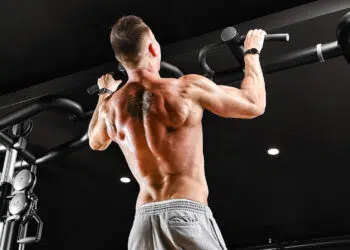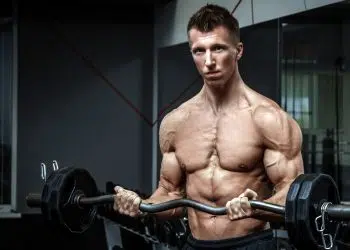The theory behind carb backloading is that it allows you to maintain or increase strength and maintain or increase muscle mass, at the same time as losing body fat. There are a few different versions of diets that all make this claim, and they all have the same components. A period of underfeeding, with a short period of overfeeding. Fat is lost during the underfeeding phase, muscle is built during the overfeeding phase.
I have personally done a lot of carb backloading dieting. Although I had no idea it had a name. I thought through trial and error I had hit on something I was calling Anabolic Keto. Although carb backloading is different in one way, because it is suggested you consume your carbs post training, where as with Anabolic Keto, I was consuming a carb meal at the end of the day, but was training in the morning. I’ll get more into the specifics and science (or scientific theory more accurately) behind Anabolic Keto at a later date. For now, I’ll focus on carb backloading.
Part of the goal with backloading is time efficiency. The plan was to make a fat loss, muscle-building system that was easy to follow and didn’t take a massive amount of planning. Like all good fitness plans, back-loading was intended to get maximum results in the shortest time – nothing new there.
It is well-known that low insulin levels, which occur in the absence of dietary carbohydrates, can accelerate the release of fatty acids, and increase fat burning, otherwise known as lipolysis. This is true even during exercise. Once carbs enter the diet during the day, for a single meal, fat burning is hampered for the entire day.
There is also no disputing that insulin sensitivity is highest in the morning and early afternoon. By the evening, it has hit its lowest point. It is also known that eating more food in the beginning of the day when insulin sensitivity is high, causes more muscle than fat to be lost during dieting. Eating most of your calories in the evening however, causes the loss of body fat and the preservation of muscle. It thus stands to reason that if one wants to burn fat, they would refrain from eating carbohydrates for as long as possible during the day.
Then there’s the issue of muscle to build. If on a fat loss diet, possibly not built, but at least spared. Insulin is the ideal hormone to target to spare muscle mass, levels of which we can manipulate with carb consumption. The issue with insulin, is that during any type of fat loss diet, the goal is to keep the levels very low. So now we’re back to either building muscle, or losing fat.
Level Up Your Fitness: Join our 💪 strong community in Fitness Volt Newsletter. Get daily inspiration, expert-backed workouts, nutrition tips, the latest in strength sports, and the support you need to reach your goals. Subscribe for free!
Post-workout nutrition is also an important consideration for growth. The maximum amount of growth possible comes from consuming high amounts of fast-absorbing proteins and fast-absorbing carbs. Studies show that muscle growth requires not just lots of calories, but lots of carbs. Having your liver or muscle tissue absorb most of these carbs would be ideal, as glycogen stores could be rapidly replenished. If the carbs replenish glycogen stores, then there won’t be any excess that could end up in fat cells.
This is where back-loading has some advantages. If we can avoid carbs during the most insulin-sensitive parts of the day, we can avoid fat accumulation. Resistance training increases skeletal muscle insulin sensitivity, but it still fluctuates through the day. We would like muscles to be at their peak of glucose absorption when fat cells are at their most dormant.
The mechanism by which muscle cells absorb glucose is not only triggered by insulin. There is also proteins that shuttle glucose through the cellular membrane. They are called glucose transporters or GLUTs.
The predominant GLUTs in muscle cells—GLUT-4, the same type as in fat cells—normally need insulin-stimulation to come to the surface of the cell where the transporters can start ferrying glucose into the nucleus for metabolism. This is called insulin-mediated translocation. Non-insulin-mediated translocation is when GLUT-4’s come to the surface to function without signaling from insulin. In a nut shell: GLUT-4’s need to be present at the skeletal muscle cell surface for the cell to use glucose and there are two ways this is accomplished. One of those ways requires insulin.
The other, the one we can use to our advantage, requires resistance training. Contracting muscles under load causes GLUT-4 translocation in muscle tissue, independent of insulin action. So weight lifting has the same effect on GLUT-4’s as insulin. This means we can make the muscles transport as much glucose during non-peak insulin-sensitivity hours in the evening, as we can during the morning. It means lifting weights makes your muscles absorb sugar whether there’s insulin or not, and whether your muscles are sensitive to it or not.
We target muscle tissue to soak up sugar at an accelerated rate while fat cells struggle to do the same. In doing so, we get optimal times to eat different nutrients, and an optimal time to resistance train.
In order to receive the benefits of both muscle-building and fat loss, you must lift at the end of the early afternoon, completing your workout to coincide with the lowest point of insulin sensitivity. Your training should start in the later afternoon, and finish in the early evening. Then the carb consumption will begin, as now your body’s inulin is low, and the muscles are primed for glucose uptake.
Now that workout time is no longer an option, you simply don’t consume any carbs until post training. You can also consume them during training if it will be extremely intense, or if you feel depleted from the day before. Research shows that the body will not accumulate fat during the workout even while consuming carbs.
After the workout, if not during, start loading carbs. The muscle tissue now has a high affinity for glucose, while fat cells won’t absorb much in the way of energy. Although lipogenesis is always hampered by weight lifting, the effect is short-lived, so during training and post training it is the ideal time to consume an abundance of carbs.
It is actually a very sound theory, with science to back it up. I personally have never tried this, as my training is always done first thing in the morning (this is one a the variations from this diet that Anabolic Keto takes into account – not everyone can train in the late afternoon, as is the rule with carb back-loading). I’d really like to hear from anyone who has tried this method. Please contact me in whatever means you are most comfortable doing so.
Part 2: My Carb Backloading Serie
Lets dive into what kind of effect carbohydrates have on our bodies, why backloading can be effective, your choice between utilizing simple or complex carbohydrates and talk about if refeeds are necessary while doing carb backloading.
The first thing I want to address is people’s concern that eating carbs in the evening is a surefire way to gain fat. You’ve probably heard the worst thing you can do is to eat carbs at night because they won’t be burned off and they’ll be stored as fat. I don’t believe that to be true (although I once did) but it’s especially not true with carb backloading. I will explain that later, but for now let’s look at some studies that go against the thinking that carbs at night are bad.
Level Up Your Fitness: Join our 💪 strong community in Fitness Volt Newsletter. Get daily inspiration, expert-backed workouts, nutrition tips, the latest in strength sports, and the support you need to reach your goals. Subscribe for free!
Firstly there have been numerous studies done on Ramadan fasting which has a meal pattern of eating a lot of carbs at night that showed neutral or even positive affects on body fat percentages. If you look more specifically at the intake of carbs at night only, there was a study done in 2011 that was published in the Journal of Obesity on 78 Israeli police officers. The group was placed on a low calorie diet, but both groups consumed the same amount of calories, carbs, protein and fat. The difference was they split them up into one group who ate most of their carbs in the evening and a control group who ate their carbs spread more evenly throughout the day. The diet ran for 6 months and they ran blood samples and took hunger scores. The results showed the group eating their carbs in the evening lost 27% more body fat and felt 13.7% fuller than the control group. Adding to this was that the level of inflammatory hormones, which can lead to heart disease and cancer, decreased by 27.8% in the evening group while the control group only decreased by 5.8%.
Carbohydrates greatly impair fat utilization by raising the hormone insulin. High insulin levels also drive up the hormone cortisol, which tells the body to store energy as fat. When you eat carbohydrates at a meal, fat burning is stalled for the remainder of the day. So if you eat carbohydrates in the morning you are hampering your body’s ability to burn fat right off the bat. If we can keep insulin levels low by avoiding carbohydrates, we can accelerate fat loss. Since insulin sensitivity is at its highest in the morning and lowest in the evening, it would stand to reason that avoiding carbohydrates during the morning and early afternoon, or really as long as possible, would be best for enhancing fat loss.
We don’t just want fat loss though, we want our precious muscle too, right? With carb backloading resistance training is done later in the afternoon or into the early evening when insulin sensitivity is at its lowest levels. It is well known that for the maximum amount of muscle growth via post-workout nutrition you need high amounts of fast digesting protein and fast digesting carbs. During your training you will be depleting your muscles of glycogen (stored carbohydrate in muscle) and they will be primed to take in glucose, but your fat cells won’t. So the carbs you will consume post-workout will be used to feed your muscle tissue, leaving little if anything leftover for fat cells. Sounds pretty good doesn’t it?
The other thing that comes into play with carb backloading is whether you want to choose complex or simple carbs in your post workout meal. If you main goal is fat loss, which is generally the goal when backloading is done, a complex carb is the better option in my opinion. If your goal is to gain more muscle, a simple carb is probably the better option as the fast insulin spike will help drive those nutrients into your muscles. Keep in mind, however, the increased insulin levels could also lead to some fat gain too, not to mention a fast insulin spike will immediately lower testosterone levels. You can’t really go wrong with either option, it’s just a personal preference based on your goals.
So to recap, with carb backloading we are avoiding carbs during the most insulin sensitive parts of the day and thus avoiding interfering with fat loss. We weight train later in the day when our bodies are the least insulin sensitive. The weight training will increase our muscles insulin sensitivity making them primed for glucose uptake, which you will give them via your post-workout carboyhydrates as well as proteins. Since we’ll be doing this carb loading at a time when fat cells are the most dormant, it makes for pretty sound plan.
Now for the issue of whether or not to include a refeed with carb backloading. Obviously it’s up to each individual, but I honestly don’t think refeeds are all that necessary with backloading. Only if you are going really truly low/no carb do I think it becomes necessary. Perhaps if you’ve been doing it for a while and you reach a plateau it could be of help. Also, the leaner you get the more likely you are to need a refeed. If you do decide a refeed is necessary you can do so once per week. The idea is to eat as many carbs as you want while keeping fats as low as possible. A lot of people believe in going crazy eating pizza or anything they want to get the carbs in, but I personally have a hard time doing any kind of diet that not only introduces junk food, but has you eat junk food in abundance.
If I were to refeed I would stick to my normal healthy complex carb sources and eat a lot of them. I’m not by any means saying you can’t get results eating the simple variety, but for me it just doesn’t fit my lifestyle. Some people swear by this method and also like it because it allows them to eat the foods they want but normally can’t have. This can be a big boost mentally for some people who struggle eating healthily most of the time. If they are able to eat those foods they crave and know they can look forward to eating them, caving into temptation is less likely and the chance to stick to a plan increases. Just like with your post-workout meal, this is simply each individual’s choice. Either way will do the trick, and you can utilize both complex and simple carbs with your refeed if you want.
Part 3: My Carb Backloading Serie
Welcome back to the My Carb Backloading Series. In part 1 I gave an introduction to what carb backloading is and some of the variations to the diet. Last week in part 2, I talked about the effects carbohydrates have on our bodies, why backloading can be effective, choosing simple or complex carbs and the idea of a refeed. This week I will be sharing the experience I had when I did carb backloading over a portion of the winter.
My plan was pretty simple – to eat like I normally would only without the carbs during the day. What I mean by normally is eating only “clean” foods, unprocessed or very minimally processed, natural whole foods. I eliminated as many forms of sugar as possible, including fruits and milk. My goal was to keep sugar under 30 grams per day. At first it proved to be a little difficult, but once I got into the swing of things I was under 20 grams every day without even thinking about it, with most of them coming in the form of vegetables.
The mainstays of my diet were eggs, chicken, salmon, tilapia, turkey, natural peanut butter, nuts, olive oil, and cottage cheese. The carbs I ate during the day were almost all vegetables, and there was no restriction on the amount of vegetables I ate. Green leafy veggies were (and always are) a big part of my diet, as well they should be. The only other real carbs I ate besides veggies during the day were avocados and the carbs you get from nuts. The carb source I ate after training in the evening was always a complex carb. I chose to stick with complex over simple to stay focused on fat loss. That carb source was usually one of quinoa, brown rice, farro, bulgar, or a sweet potato. I shot for a daily macro split of 45% protein, 40% fat, 15% carbs.
I lifted weights in the late afternoon/early evening as any carb backloading plan demands and would consume just one carb source, shooting for between 20-30 grams, post-workout. Generally that post workout meal would be dinner but if training later in the evening I’d eat it with my post-workout shake since dinner was before my workout. Those later workouts weren’t optimal for backloading, but they still worked. Life is going to happen and you just adjust accordingly.
Consistency is something I shot for no matter what happened with training times or anything else. It was always one complex carb source in the evening, no matter what. Whether it was an off-day, or if I trained in the morning like I often do on the weekends. I still consumed my one carb source in the evening when insulin sensitivity is at its lowest. The meal with the carb source was almost always the last meal of the day with the exception of a casein shake before bed. I didn’t alter meal times or anything like that either. I woke up and ate breakfast like always and tried to eat every few hours.
I didn’t do anything such as go ten days with hardly any carbs or anything like that. I just jumped right into the plan. I can’t lie, when I started the plan I was extremely tired. I felt very fatigued for the first 3 days until I got that carb source in the evening. By the 4th day I felt much better and by a week I had more energy than ever before. Every person I’ve talked to who started backloading has gone through this same thing. It’s important to tough it out during this stretch. Eventually feeling great and, you know, that whole results thing will make it well worth it. I did notice a slight drop in strength in the weight room while on carb backloading but that was anticipated. Taking away carbs from your pre-workout will do that, but the anabolic response will be better. The results in my body to me were well worth the slight loss of strength.
Now for the moment you’ve all been waiting for, the results of my time while on carb backloading. I had just finished up an almost 4 month-long lean bulk which brought my weight up to 193 lbs from 180 lbs. With the help of carb backloading, in a little under 3 months I got down to 176 lbs. I didn’t really gain muscle, but I spared the muscle I had gained from my bulk while leaning out. I took measurements in my left bicep and left quad at the end of my bulk and at the end of my cut and both readings were the same. It’s pretty hard to ask for more than that! Unfortunately I don’t know what my body fat was before or after the bulk but at the end of my cut it was down to 9.4%, a number I never expected to see when I started. I do know that I was much leaner than I was before the bulk with more muscle mass. To have ¾” larger biceps while weighing 4 pounds less, well that’s pretty fun! I’ve included a picture showing how I looked at the end of my bulk compared to how I looked 2 months into carb backloading. I didn’t take one at the end but at the 2 month point I was already down to 179 lbs.
So of course with all that said I’m personally a big fan of carb backloading. It’s hard to argue with results that cut that much fat while retaining muscle. I want to be clear that this plan is what worked for me. Each person is unique and different things work for different people. It’s important to find what works for you, and not someone else. You can certainly use it as a starting point and a guideline, see how things work for you, and alter as needed. As you’ve seen from all three parts of this series, there are plenty of options.
So what’s up next for me you ask? Well since I really enjoy experimenting and seeing what works for me I’m once again trying something completely new to me. I’m currently about a month into a bulk while in ketosis. The purpose is to see if I can add some decent muscle mass while keeping body fat levels low. After I finish bulking I’ll likely stay in ketosis, drop the calories to cut and see how things turn out. It’s been a challenge eating the amount of food necessary to bulk without the luxury of carbs, but it’s a challenge I accept. I enjoy challenges and trying new things. If it doesn’t work it doesn’t work, but at least I will have given it a real shot. I’m not sure when I’ll do carb backloading again but I’m sure I will be trying it again at some point. Most likely next time I’ll switch it up from complex carbs to mostly simple carbs post-workout to see what kind of difference I get.
So there you have it. That wraps up my series on carb backloading. If you decide it’s something you want to try and you have any questions feel free to contact me however you feel comfortable and I’ll help you as much as I can!
Happy Lifting!












Justin, after reading your article on “Carb-back loading” and “anabolic Ketosis,” I wanted to ask you about your macros. I am 47years old, 193lbs at 6′ and I am in a bulking phase gaining a modest .5lbs -1.0 lbs per week for the past 10 weeks. However, I hate the added fat I’ve gained and want to try the anabolic ketosis program you mention. I noticed your macros in the carbback loading to be daily macro split of 45% protein, 40% fat, 15% carbs. Do these macros change under the keto/anabolic program? If so, what do you recommend?
Hello Matthew,
Thank you for reaching out and for your interest in carb back-loading and anabolic ketosis. Based on your current bulking phase and concerns about added fat, shifting your approach could indeed be beneficial.
Regarding your question about the macros for an anabolic ketosis program: While my article mainly focuses on carb back-loading, which typically involves a macro split of 45% protein, 40% fat, and 15% carbs, an anabolic ketosis program would slightly adjust these ratios. Anabolic ketosis emphasizes a higher fat intake and extremely low carb consumption to maintain a state of ketosis, which is crucial for the program’s success.
In an anabolic ketosis regime, your macros might shift to something closer to 60-65% fat, 30-35% protein, and 5-10% carbs. This shift helps your body to enter and stay in ketosis, where it burns fat for fuel instead of carbs. However, remember that individual responses can vary, and it’s essential to monitor your body’s reaction to these changes.
I suggest starting with this macro guideline and then adjusting based on your body’s feedback and progress. Keep track of your energy levels, strength, and body composition changes. It’s also a good idea to consult with a nutritionist or a healthcare professional to tailor the program to your specific needs and to ensure you’re getting all the necessary nutrients.
Remember, the key to success in any dietary approach is consistency and adaptability. Listen to your body and adjust as necessary.
Best of luck on your fitness journey!